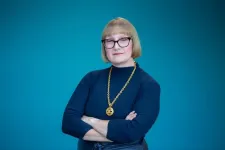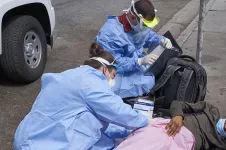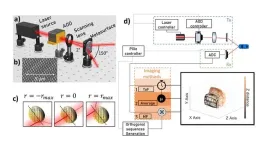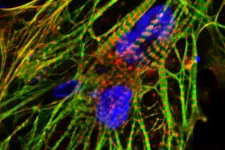(Press-News.org) Charlottesville, VA –The Center for Open Science (COS) is delighted to announce the appointment of Yvette Seger, PhD to its Board of Directors. Seger brings impressive experience and strategic leadership across a range of areas that aligns well with COS’s mission, vision, and activities, including policy analysis, advocacy, and implementation.
Seger holds multiple roles as Director of Science Policy, Deputy Director of the Office of Public Affairs, and Director of Strategic Scientific Program Advancement at the Federation of American Societies for Experimental Biology (FASEB).
A geneticist by training, Seger tracks critical science policy and regulatory actions affecting biological and biomedical research and ensures FASEB policy recommendations evolve in tandem with rapidly advancing science and technology. She applies her policy acumen to the development and implementation of two multi-million-dollar strategic investments: FASEB DataWorks! and the FASEB Diversity, Equity, Accessibility, and Inclusion (DEAI) Program. Launched in September 2021, FASEB DataWorks! seeks to bring the biological and biomedical research communities together to advance human health through data sharing and reuse. Through FASEB’s DEAI program, she is leading the first of its kind to provide diversity and inclusivity programs for working scientists throughout the life sciences.
Seger has spearheaded community discussions and recommendations to enhance research rigor and reproducibility in the biological and biomedical sciences and has been a long-time proponent of open scholarship. Her contributions to the open scholarship community include co-chairing the Alliance for Open Scholarship, a cohort of societies and associations collaborating to promote a culture of open research, and serving as an ex officio member of the National Academies of Science, Engineering, and Medicine’s Roundtable on Aligning Incentives for Open Science.
All of Seger’s experience and current efforts are especially relevant for COS, as the organization seeks to enhance its support of the biological and biomedical sciences communities and continue its policy advocacy and implementation efforts, particularly in light of catalyzing policy change initiatives such as the recent OSTP Memo, etc.
“As a close follower of the Center for Open Science’s work, I am honored to join its Board of Directors and help further its mission to promote open science practices in the research community, particularly across the biological and biomedical research community represented by FASEB,” says Seger.
“COS has already done considerable work to ensure that its infrastructure, training, policy, and research efforts are aligned and prepared to support specific open science policy requirements. Yet, the opportunity to support further policy implementation required to fully realize the promise of global policy initiatives is significant,” said Alison Mudditt, COS’s Board Chair. “Yvette brings a wealth and diversity of expertise to these critical priorities, and we are all looking forward to her contributions to enhance openness, integrity, and reproducibility in science.”
###
About Center for Open Science:
Founded in 2013, COS is a nonprofit culture change organization with a mission to increase openness, integrity, and reproducibility of scientific research. COS pursues this mission by building communities around open science practices, supporting metascience research, and developing and maintaining free, open source software tools, including the Open Science Framework (OSF). Learn more at cos.io.
END
A newly described type of chemistry in fungi is both surprisingly common and likely to involve highly reactive enzymes, two traits that make the genes involved useful signposts pointing to a potential treasure trove of biological compounds with medical and chemical applications.
It was also nearly invisible to scientists until now.
In the last 15 years, the hunt for molecules from living organisms — many with promise as drugs, antimicrobial agents, chemical catalysts and even food additives — has relied on computer algorithms trained to search the DNA of bacteria, ...
The Centers for Medicare and Medicaid Services (CMS) officially recognized that medical care can be delivered on the street, making it possible for providers like USC’s Street Medicine team to be reimbursed for services provided to people who are currently unhoused.
The decision, which was announced on June 28, 2023, was the result of a multi-year effort on the part of leaders of USC Street Medicine and the Street Medicine Institute to have CMS create a place of service (POS) code for the street. As a result of this designation, street medicine providers nationwide will be able ...
A University of Arizona Cancer Center researcher was awarded a $1.3 million grant from the National Cancer Institute to study the effectiveness of lifestyle interventions in American Indian patients with obesity-related solid tumor cancers who are preparing for surgery.
According to principal investigator Jennifer Erdrich, MD, MPH, there are 13 cancer subtypes linked to obesity that account for 40% of all cancers diagnosed annually in the United States.
American Indian and Alaska Native populations are more than 1.5 times more likely to be obese than the general population and have some of the lowest cancer survival rates in the nation. Many factors ...
Key takeaways
A UCLA-led study has shown that hardship experienced by mothers during their own childhood or during pregnancy is reflected in the composition of their 2-year-old children’s gut microbiome.
It was previously understood that in rodents, prenatal stress affects microbiomes into adulthood, but how long after birth the effects lasted in humans was unknown.
The changes to this community of microorganisms are likely among the ways that hardship affects a child’s socioemotional development.
Hardship experienced by mothers during their own childhood or during pregnancy is reflected ...
Today, the U.S. Department of Energy (DOE) announced the release of a Draft Request for Proposals (RFP) for the selection of a management and operating (M&O) contractor for the Fermi National Accelerator Laboratory (FNAL).
DOE is soliciting public feedback on the draft RFP. Interested parties are encouraged to take advantage of this opportunity to provide comments regarding the draft contract performance requirements. The draft RFP will be open for public comment until August ...
“It’s a great privilege to host the World Conference of Science Journalists 2025,” says Mandi Smallhorne, president of SASJA. “As it is the first time the conference has ever been held on African soil, this is truly a historic event, we’re delighted to be the pioneers! We look forward to welcoming the science journalists of the world to our home; we are sure it will be an eye-opening and rewarding experience. Our beautiful country has a lot to share, and that includes some fascinating scientific experiences, from the Square Kilometre Array, to cutting edge genomic sequencing, to the Cradle of Humankind. We are brewing ...
Pulsed laser scanning lidar is a core technology for autonomous driving and robotic mobility. Herein, a directional light pulse is backscattered by a reflective object and the elapsed time between emission and detection of the pulse is used to calculate depth. These direct time-of-flight (d-ToF) measurements of returning light pulses enable the three-dimensional imaging of complex scenes.
At present, lidar technology requires numerous developments, including enhancement of the observation field of view (FoV) with high angular resolution, improvement of the imaging frame rate, extension of the ambiguity range by reducing the signal-to-noise ...
Researchers at the University of Illinois Chicago have identified a process by which enzymes can help prevent heart damage in chemotherapy patients.
The enzymes are normally found in a cell’s mitochondria, the powerhouse that produces energy. But when heart cells are put under stress from certain types of chemotherapy drugs, the enzymes move into the cell’s nucleus, where they are able to keep the cells alive. The paper is published in Nature Communications.
“As chemotherapy has become more and more effective, we have more and more cancer survivors. But the tragic ...
How useful a memory is for future situations determines where it resides in the brain, according to a new theory proposed by researchers at HHMI"s Janelia Research Campus and collaborators at UCL.
The theory offers a new way of understanding systems consolidation, a process that transfers certain memories from the hippocampus – where they are initially stored – to the neocortex -- where they reside long term.
Under the classical view of systems consolidation, all memories move from the hippocampus to the neocortex over time. But this view doesn’t always hold up; research shows some memories permanently reside ...
Key Takeaways:
At job separation, 41.4% of employees cash out 401(k) savings, most draining their entire accounts.
Cashing out increases with the proportion of the 401(k) balance contributed by employers. The “account composition effect” is most likely driven by behavioral rather than economic explanations.
The cash-out option was presented to terminating employees in a salient way, unintentionally nudging them to withdraw their 401(k) savings.
BALTIMORE, MD, July 17, 2023 – When researchers set out to study 401(k) retirement savings ...



